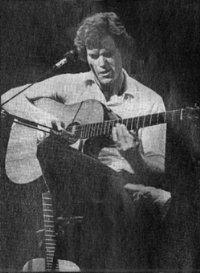Leo Kottke: His Techniques, Guitars, Slide, & Tricks of the Trade
by Gil Podolinsky
Page 7
 |
No, it's stock. It has the bridge backwards which forces you forces you to play back towards the bridge because you get a more solid note; it's not as noisy, and the strings don't spin as much. I also tried an adjustable bridge on a 6-string, but it doesn't work.
Onstage, do you go direct, through an amp, or what?
It depends on whether my soundman is with me, as well as on the room or the system, etc. There are many variables. The soundman compensates by taking out the interfering resonances. With graphic equalizing you can EQ the third octave by finding the peak in a room and pulling it out. You don't really modify the guitar, just control the problem areas of it, and by doing that you get a better level. Below 100 cycles you have a problem with boom and the whole bottom end of the guitar.
Do you still use accessories?
I have an MXR phaser that I use occasionally during a set, but I'm skeptical of effects for what I do because they can be very disruptive of the flow. I don t use as much as I would like. I like the Echoplex, digital delay. Compression can do nice things for the color of the guitar, but it's hard to do live. I don't own any of these devices.
Does the fact that most guitarists use these devices deter you?
No, I really admire those sounds. To me the guitar is the most flexible instrument around. You can do anything with it, so it doesn't bother me if other people use effects. The biggest appeal of the guitar is its tone, and the use of effects is like a literalizing of what you're hearing in there anyway. Phasing is a continual fact of life on a 12-string, it's always phasing, so effects really isolate one aspect and bring it out.
Are there any special tricks you use- not necessarily a conventional device?
One of a couple of tricks I've picked up both for recording as well as performing is to stick a piece of felt under the strings and behind the nut. I currently have a piece of sponge rubber up there. What that does is eliminate the over-ring and extra resonance. It's really effective on a 12-string. The way you can tell whether you need it or not is to strum your guitar, then immediately damp it. After you damp it listen to how much crap is swimming around in there. Depending upon the guitar, you ll hear a whole lot of white noise -- just jangley crud -- which is caused by the strings behind the nut resonating through your box. If you stuff something in to deaden them, it's quiet. You'll hear a little bit of ring out, but that's intended. It's done a hell of a job on the Gibson. It's a subtle thing to eliminate over-ring. I've found a neat trick, especially for the 12-string: if you have boom, which happens a lot, take a triangular-shaped piece of paper a little heavier than typing paper, and -- let's say the bridge is south and the nut north -- cover the southwestern quadrant of the soundhole so that you have this thin corner sticking in. That will stop your boom. I'm about half through writing a book which I may end up publishing myself, which will give advice on how to improve the sound of the 12-string, repairs, and songs I've recorded completely annotated. Describing the hand positions is especially difficult. There'll be plenty of photographs, I hope. It won't be a regurgitation of the standard Mel Bay approach.